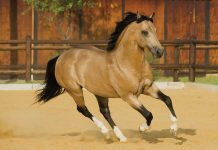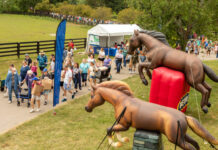If you’ve spent some time walking and jogging your horse, chances are you’re looking forward to loping. For most riders this is the most exciting gait and many of the most popular western sports like barrel racing and reining are done at the lope. There’s just nothing like it.Although the lope is easier to sit than the jog, it’s also the gait a horse uses when he’s scared. Control and communication are especially important when you decide to speed things up.
Never try your first lope in an unfamiliar place and never out on the trail. It’s best to try it in a round pen or an arena if you don’t have a round pen. You might ask your trainer (if you have one) to let you lope for the first time on the lunge line.
When loping for the first time, ride two handed with your reins fairly short so you have more control. Not short enough to be pulling on his mouth—just enough to take out the slack. Walk and jog your horse to make sure he’s calm and ready to pay attention to you. If he’s nervous or pulling on the bit at these gaits, he is not ready to lope. See if he’s soft in the bridle, which means he will give you his nose both right and left and slow down when you just barely lift the reins.
Before you ask your horse to lope, he must understand that he should move away from pressure from your legs. For him to lope correctly, he must start his motion from his hind end. You control this part of his body with your legs. Spend some time moving his hip over at the walk and jog. Left leg pressure should make his hip move to the right. Your right leg asks him to move to the left. If he stays calm and keeps going forward, you’re ready to ask for the lope.
Make sure your horse is in position to take the correct lead. What’s a correct lead? When a horse lopes, the front and back legs on one side are in front of his other legs. If he’s on the wrong lead or if he doesn’t lope with his hind legs—called cross firing—and he will not be balanced.
To help your horse stay correct, start jogging in a circle to the left. Look where you want to go and keep your shoulders square and your hands in front of and below the horn. Your heels should be down and the balls of your feet on the stirrups. This foot position helps keep you balanced.
Lift your left rein gently to tip his nose to the left just a little. Make sure your other rein is steady so he doesn’t think TURN. Then squeeze with your right leg behind the cinch and kiss to him (make a loud smack noise with your lips.) Making the kissing sound lets your horse know that you want to lope and not just a sidepass.
It’s OK if he doesn’t lope right away. It’s better at this point to let him find the lope by himself so he doesn’t get worried about it. Keep asking with your leg pressure. Don’t take away your leg until he lopes—that’s the release that lets him know he did the right thing. Make the kissing sound again and run your reins forward on his neck a little.
Only your hands should go forward—not your whole body. If you lean forward you put too much weight on his front end and make it hard for him to use his hind end. Sit back on your pockets so when he starts to lope you’ll be in the correct position. Your seat is important for balance, and it’s what keeps your horse’s motion flowing.
If you get pitched forward, grab the cantle not the horn. Holding the horn pulls you farther forward and makes you stiff. Holding the cantle brings you back where you need to be. If he starts to get speedy, take a light, steady contact with your reins and roll your hips back. Make sure you’re not squeezing with your legs, and don’t pull on the bit. Pulling is an invitation to your horse to pull harder and get “chargy.”
If he doesn’t slow down, gently bring one rein back to toward your belt, bringing him into a small circle. This is a good thing to practice before you have a problem. If you’re horse runs off with you, you won’t panic if you’re prepared.
When he starts to lope, make sure to keep your hands still. Follow the rocking motion with your hips. Go a short distance, and then ask him to slow down to a jog, then a walk. Pet him and let him relax for a minute or two to let him know how great he is. Ask again and it will probably take fewer strides for him to lope. Pretty soon he’ll lope off with just a kiss and leg pressure from a standstill.
Never let your horse change gaits unless you ask him to. He should always move at a calm, controlled pace because he respects and understands your requests.
If your horse gets nervous or wants to speed up at the lope, make sure he doesn’t have a tack or health problem. Tooth problems or a bit that doesn’t fit right can make a horse run off.
Don’t overwork your horse. Loping while balancing a rider is hard work. If he’s breathing hard let him rest. Don’t just lope in circles in an arena. Lope straight lines and diagonals, and some days just go for a slow trail ride at the walk.





